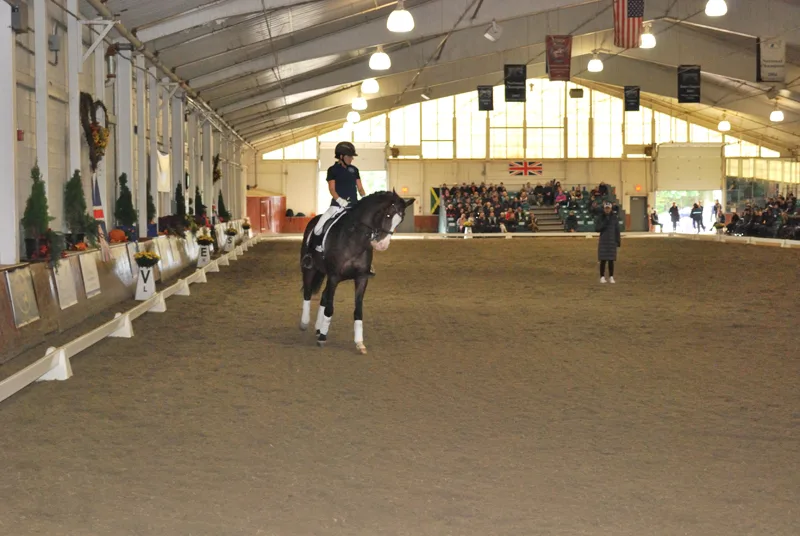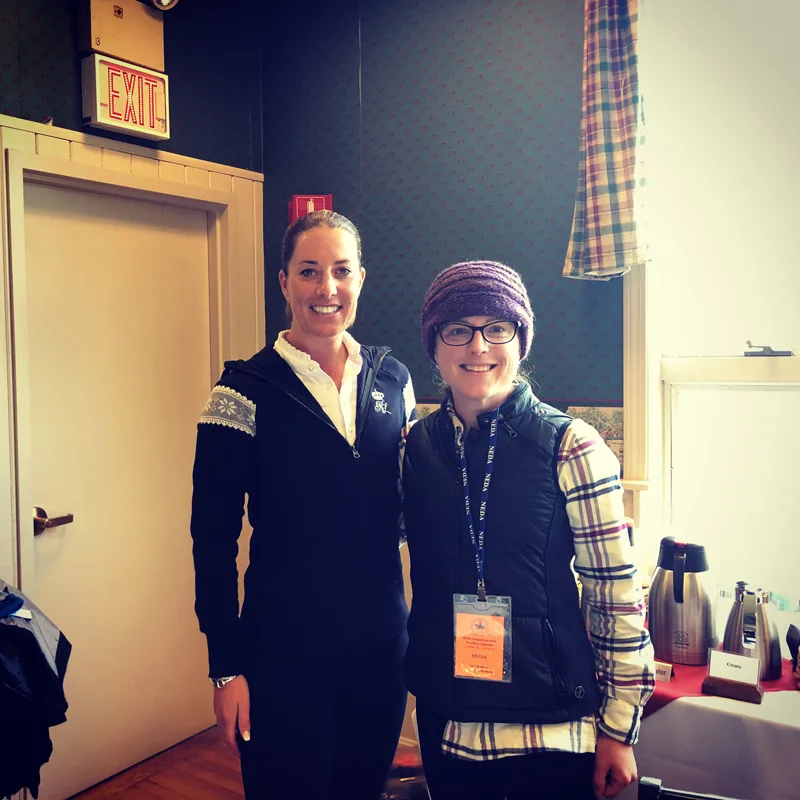During the afternoon sessions of the New England Dressage Association’s Fall Symposium, we were lucky to watch horses and riders training at Developing Prix St. Georges through Grand Prix.
Dujardin spoke about the training schedule of her personal horses once they are schooling the advanced levels. “One simply cannot ride all the FEI work in each session,” she stated. “First off, there would not be enough time. Secondly, it would be far too difficult for the horse. You must choose a couple areas to focus on and really learn to work on movements within exercises. This will both make it less physically stressful for the horse and will also prevent him from anticipating what might be next in a test.”
First up was Linda Currie riding Frost T, a big handsome guy working towards Prix St. Georges. At this level the expectations are higher, and the horse’s reaction time must constantly be evaluated.
“Is the reaction good enough?” Dujardin inquired. “Were you completely satisfied? If the answer is no, then he must be made sharper!”
As Currie worked to develop a quality pirouette canter, Dujardin questioned Frost T’s energy. “I want to see more jump in the canter,” she said, “especially when you collect. I want to see bounding and not a slow, flat gait.”
Dujardin asked Currie to correct this by riding a very forward canter after each request for collection. This brought much more jump into his stride.
Even when Currie asked for a walk transition before a break, Dujardin was on her about the quality.
“Was that a good transition?” Dujardin queried. “Was it a 10? Because it should be. I have high expectations! One must pay attention to the details.”
When she still felt unsatisfied with the results, the now famous quote was brought into play: “Linda” said Dujardin with mock severity, “You are riding like a fairy on a Christmas tree!!” She (and Currie) shared a laugh with the crowd, and Currie went back to work, for another round of perfect 10 transitions.
Some focused work on developing a more expressive trot was a highlight of this session. Dujardin had the pair shift gears from medium trot to collected trot to baby passage. This work brought a much greater level of elevation to his gait and was exciting to watch.
Currie wrapped up her session by nailing a set of tempi changes, after gloriously miscounting enough of them to prompt some gentle teasing from Dujardin. “LINDA… can you count??”
Currie can, in fact, count, and she showed all of us just how well she knows numbers by ripping off a perfect line of tempis in fine style. (Currie must be an accountant. I must be tired. I am making Dad jokes. But really, good job.)
“I swear I can count,” Currie said with a laugh after her ride. “I just sometimes can’t get my legs to work with my brain.” (Yep, I get it!)
ADVERTISEMENT
“I was especially excited to work on building up a better trot with Frost T by using some baby passage steps,” Currie continued. “I wasn’t sure he was ready for the challenge, but Charlotte showed me that he was. I feel like this tool will unlock a whole new trot for him.”
Next on the agenda was Roberta “Bobbi” Carleton, who was called in last minute when a rider needed to bow out. I can only imagine the pressure she was under, being a pinch hitter! Her 8-year-old mare, Flingh’s Dream, is currently schooling PSG. This was a young horse, still developing the strength needed to show adequate collection for the level.
Dujardin again stressed the need to work on exercises to develop movements, rather than schooling just the movement itself. “Not only will you then be able to adjust the difficulty level of the exercise as needed,” she explained, “but you prevent the horse from always anticipating what they are about to do.”
We were able to see the progression through this concept during Carleton’s canter work. Rather than simply training the pirouette, Dujardin had her perform a half-pass to centerline, followed by a shoulder-in, and finally a 10-meter schooling pirouette. The set-up for the movement was so thorough that the final turn to the pirouette was almost an afterthought. It was a lovely moment in a high-pressure session, where the crowd was riding every stride, clucking along in time.
Unfortunately, later in the day, Flingh wasn’t feeling well, so Carleton brought her home. She then proved herself to be the pinch-hitting queen by promptly loading up her other horse, Kir Royal, and getting right back to it on Sunday.
And what a fun session this was to watch! Carleton hoped to work on his changes, as PSG is in his near future, and his changes were still hesitant. Dujardin felt his canter was a bit ground bound, and she encouraged Carleton to “yee haw” around until the horse felt inspired.
“He needs to get some air under his feet,” Dujardin commented. “Get the canter better, and the change will be there!”
Some work in medium canter directly into travers was the final step in improving his flexibility.
We revisited an exercise that we had seen the previous day, on a very different horse, the 10-meter figure-eight with a flying change positioned towards C. This was very effective with Carleton’s mount, as she was able to ride more boldly and use the wall, rather than her hand, to control the forward motion, and they made several stylish changes.
The trot work after canter was a highlight for everyone involved. Bold mediums into baby passage brought a whole new trot to this horse’s resume. “Look at you, Bobbi!” exclaimed Dujardin. “We have fixed your changes, and now you are trotting for GOLD!”
In between sessions Dujardin spoke to the audience about the need to be fit and strong as an equestrian. “Core strength,” she said. “It is every rider’s best friend, and you just can never be too strong in your back, hips and stomach.”
Out of the saddle Dujardin has a regular conditioning program that involves work with weights, stability balls and TRX. “Everything that is awful,” she joked.
She also has the kind of team one would expect for the elite-level athlete that she is, including regular physical therapy. “I believe that I need regular tune-ups,” she said. “Carl [Hester] on the other hand, says he is a Rolls Royce and needs no work!”
ADVERTISEMENT
Clearly, Dujardin and Hester are quite a team, and she referenced their slightly different but very complementary training styles many times. “We balance each other out,” she said fondly. “I’m always going for broke, and sometimes he needs a bit of a kick. We work well together.” (And if Carl Hester needs a kick then I expect the rest of us need a YEE HAW!!)
Wrapping up the day was Hope Cooper, an under-25 Grand Prix rider, and her mount Don Diamond. I’m sure that as a very important journalist (or an equestrian who occasionally plays journalist) I should remain impartial, but I’m really very fond of this horse. He has a great expression and always looks happy—and, of course, he’s a very talented upper-level horse. (But really, he’s CUTE!) The focus of his Saturday session was mostly on canter work.
After finding improved straightness and balance in the one-tempis by using the wall to improve stability (with great success), they moved on to the canter pirouettes on centerline. We got to witness the logical progression of an exercise from a previous session. Cooper began in canter half-pass to centerline, established a shoulder-fore position to ward off continued sideways motion, and then rode a pirouette “that should start small, and finish BIG. Which is usually the opposite of what happens,” Dujardin said. “Most people simply half-pass the first two strides of the pirouette, meaning that they are no longer on centerline when they actually begin to turn. Then they ride a very active first half of a pirouette and then tumble out of it.”
Using the shoulder-in as a wall to prevent the accidental half-passing, the pirouette happened more accurately, without the negative anticipation and was rewarded with applause and praise from Dujardin.
“It was so helpful to see the improvement of my pirouettes with what was actually a very small correction,” said Cooper. “It is easy to forget exactly what the judge sees when sitting on the back of a horse. It was really good to be reminded that I can really control and really influence each step.”
In the next session they focused on trot work, specifically passage and piaffe. “Ride the movement to 100 percent,” Dujardin said. “Really put more oomph into each passage step. Focus on the details of how each stride feels. Is the power there? Is he good to the hand?”
Don Diamond is a horse who is naturally quite up in his frame, and Dujardin asked Cooper to ride him just a bit lower and rounder in the neck to improve swing over the back. As the passage gained elevation Dujardin reminded Cooper to continue riding each stride for maximum power and thoroughness.
“This is what everyone goes through,” she reminded. “Just keep correcting; even if it feels hard, it doesn’t mean it is wrong.”
Cooper did some halts on centerline to wrap up the session. This was a moment that proved that sometimes the things that look easy are the most challenging! Cooper was persistent in her quest for the perfect halt (because the devil is in those pesky details!), and when she finally got it, the crowd cheered.
Knowing that Dujardin is a woman of amazing skill, incredible standards and drive beyond compare I was curious to know if she had ever had to struggle with something in riding. (Or is she actually perfect enough to live in a struggle-free zone? If so, I’m moving there.)
“Of course I have had challenges,” she said with a laugh. “For a long time, the canter zigzag and the pirouettes felt just impossible. I would complain to Carl that I felt I’d never, ever get them, but I persisted. And I was lucky enough to have him both as a coach and as a person who I could watch training his horses daily. And he did those movements right, and eventually I did as well. Since I had to work really hard to figure those movements out, I feel that I am truly great at them now.”
She continued to say, “There are people who get to a wall, and they quit. And there are people who get to that wall, and they climb it. I am a person who climbs the wall.” (I was literally like #inspiration. Not that I was fangirling or anything!!)





















